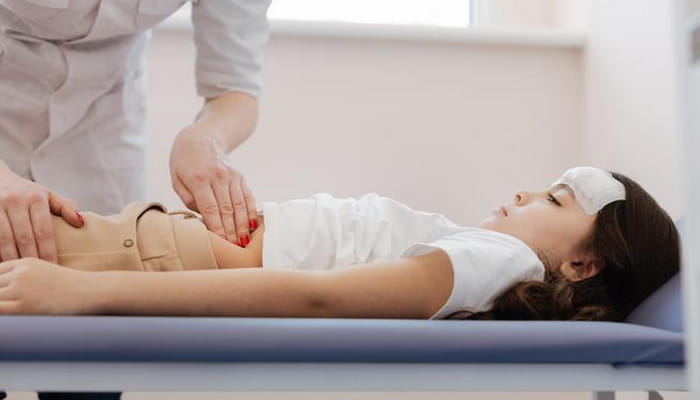Зміст
Appendicitis is one of the most common problems in pediatric gastroenterology. Children and adolescents aged 10–19 years are at greatest risk. Classic symptoms of inflammation include severe abdominal pain and vomiting.
Undiagnosed appendicitis can lead to diffuse peritonitis and even death. Any sudden and severe abdominal pain in a child should see a doctor. Unfortunately, the symptoms of appendicitis in children are sometimes atypical and suggest other diseases, which is why the disease is often treated too late.
Why does appendicitis occur?
The appendix is a blind diverticulum of the initial part of the large intestine, i.e., the cecum. Most typically it is located in the right iliac fossa, although other locations are also found. Its role in the human body is still not fully understood. There is a fairly large amount of lymphatic tissue (lymph nodes) inside the appendix, so it most likely serves a protective function. However, removing the appendix does not cause any adverse symptoms or increase susceptibility to infections.
The cause of approximately 80% of appendicitis remains unknown. Due to its location in the digestive tract and its narrow lumen, the appendix is typically clogged with feces. Obstruction of this structure can also be caused by post-infectious swelling of the lymphatic tissue located in it. In children, the appendix can also become clogged with parasites such as pinworms. These situations lead to pressure on the wall of the appendix and, as a consequence, to its ischemia and the proliferation of bacteria contained in it.
What are the symptoms of appendicitis in children?
Appendicitis is characterized by a huge variety of symptoms and their individually varying intensity. Symptoms may be similar to food poisoning, for example.
The most typical symptom of appendicitis in children is abdominal pain. It is described as very strong and colic – it is worse during systole and gives a moment of relief during diastole. Initially, the pain is most intense around the navel, and after a few hours it moves to the area of the right iliac fossa. It gets worse with coughing and body movements. In most cases, children experience loss of appetite, nausea, and even profuse vomiting. Diarrhea may also occur.
Fever usually does not occur, body temperature does not exceed 38 °C, but the heart rate and pulse increase. The child becomes apathetic, grumpy, does not want to play, does not want to move – lying down, he tucks his legs in to protect his right side. Rapid hand pressure on the abdomen (Blumberg’s sign) causes very severe pain and crying.
When the appendix is located in a different location than usual, such as behind the bladder, urinary symptoms may occur. These include frequent urination or a painful urge to urinate.
With appendicitis, a periappendiceal abscess may occur. Sometimes the wall of the appendix becomes perforated, that is, holed. This leads to the entry of infected intestinal contents into the sterile abdominal cavity and the development of diffuse peritonitis. Perforation of the appendix is manifested by sudden, even more severe pain in the abdomen. Symptoms of shock may appear. This is a life-threatening condition.
How is appendicitis diagnosed?
Diagnosis of appendicitis in children is not always quick and obvious. It is necessary to collect anamnesis and conduct a thorough examination of the abdominal cavity by a doctor. The presence of characteristic Yavorsky symptoms (pain when pressing on the right iliac fossa when lowering the right leg) and Rovsing’s symptoms (pain in the right lower abdomen when pressing with the hand on the left iliac fossa) can lead to a correct diagnosis.
Blood tests can help with diagnosis—high levels of C-reactive protein (CRP) and an elevated white blood cell count indicate active inflammation. Urine is also collected for testing to rule out urinary tract infections, which can cause similar symptoms.
Ultrasound examination (ultrasound) of the abdominal cavity can, although not always successfully, detect an inflamed appendix (enlarged more than 6 mm).
What is the treatment for appendicitis?
Treatment of acute appendicitis involves surgical removal (appendectomy). It can be performed in two ways – the classical method, i.e., opening the abdominal cavity (laparotomy), or laparoscopically. Before the procedure, a single dose of antibiotic is administered prophylactically. A periappendiceal abscess must be drained.
Conservative treatment with antibiotics and analgesics can only be recommended in the case of periappendiceal infiltration (consisting of surrounding tissues). However, after about 8 weeks, an elective appendectomy is performed. Early surgical intervention leads to complete recovery, so the prognosis for this disease is very good.








